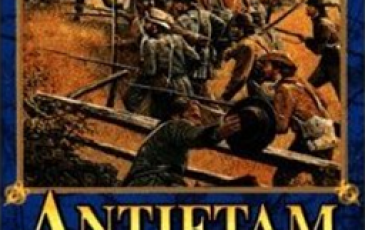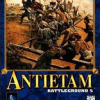5 May 62, Williamsburg, Va - Battleground 5: Antietam

| Rating: | 0 (0) |
| Games Played: | 0 |
| SM: | 7 |
| Turns: | 36 |
| Type: | Custom |
| First Side: | Union |
| Second Side: | CSA |
| Downloads: | 39 |
5 May 1862, Williamsburg, Va [Curt Cabbage]
Brig. Gen. Joseph Hooker's 2nd division of the III Corps was the lead infantry in the Union Army advance. It assaulted Fort Magruder and a line of rifle pits and smaller fortifications that extended in an arc south-west from the fort, but was repulsed. Confederate counterattacks, directed by Maj. Gen. James Longstreet, threatened to overwhelm Hooker's division, which had contested the ground alone since the early morning while waiting for the main body of the army to arrive. Hooker had expected Brig. Gen. William F. "Baldy" Smith's 2nd Division of the IV Corps, marching north on the Yorktown Road, to hear the sound of battle and come in on Hooker's right in support. However, Smith had been halted by Sumner more than a mile away from Hooker's position. He had been concerned that the Confederates would leave their fortifications and attack him on the Yorktown Road.
Longstreet's men did leave their fortifications, but they attacked Hooker, not Smith or Sumner. The brigade of Brig. Gen. Cadmus M. Wilcox applied strong pressure to Hooker's line. Regimental bands playing Yankee Doodle slowed the retreating troops as they passed by, allowing them to rally long enough to be aided by the arrival of Brig. Gen. Philip Kearny's 3rd Division of the III Corps at about 2:30 p.m. Kearny ostentatiously rode his horse out in front of his picket lines to reconnoiter and urged his men forward by flashing his saber with his only arm. The Confederates were pushed off the Lee's Mill Road and back into the woods and the abatis of their defensive positions. There, sharp firefights occurred until late in the afternoon.
While Hooker continued to confront the Confederate forces in front of Fort Magruder, Brig. Gen. Winfield S. Hancock's 1st Brigade of Baldy Smith's division, which had marched a few miles to the Federal right and crossed Cub's Creek at the point where it was dammed to form the Jones' Mill pond, began bombarding Longstreet's left flank around noon. Maj. Gen. D.H. Hill, commanding Longstreet's reserve force, had previously detached a brigade under Brig. Gen. Jubal A. Early and posted them on the grounds of the College of William and Mary. Hearing the sounds of Union artillery, Early and Hill hurried in that direction. Splitting his command, Early led two of his four regiments (the 24th and 38th Virginia Infantry) through the woods without performing adequate reconnaissance and found that they emerged not on the enemy's flank, but directly in front of Hancock's guns, which occupied two abandoned redoubts. He personally led the 24th Virginia Infantry on a futile assault and was wounded by a bullet through the shoulder.
Hancock had been ordered repeatedly by Sumner to withdraw his command back to Cub Creek, but he used the Confederate attack as an excuse to hold his ground. As the 24th Virginia charged, D.H. Hill emerged from the woods leading one of Early's other regiments, the 5th North Carolina. He ordered an attack before realizing the difficulty of his situation—Hancock's 3,400 infantrymen and eight artillery pieces significantly outnumbered the two attacking Confederate regiments, fewer than 1,200 men with no artillery support. He called off the assault after it had begun, but Hancock ordered a counterattack. The North Carolinians suffered 302 casualties, the Virginians 508. Union losses were about 100. After the battle, the counterattack received significant publicity as a major, gallant bayonet charge and McClellan's description of Hancock's "superb" performance gave him the nickname, "Hancock the Superb."
At about 2:00 p.m., Brig. Gen. John J. Peck's brigade of Brig. Gen. Darius N. Couch's 1st Division of the IV Corps arrived to support and extend the right of Hooker's line, which had, by this stage, been pushed back from the cleared ground in front of Fort Magruder into the abatis and heavy wood about 600 – 1,000 yards (910 m) from the Confederate fortifications. The morale of Hooker's troops had been affected terribly by the loss of Captain Charles H. Webber's Battery "H" of the 1st U.S. Light Artillery and Captain Walter M. Bramhall's 6th Battery of the New York Light Artillery. Peck's arrival on the field and his brigade's recovery of Bramhall's battery came at a critical moment for Hooker's division, which was on the verge of retreat.
Brig. Gen. Joseph Hooker's 2nd division of the III Corps was the lead infantry in the Union Army advance. It assaulted Fort Magruder and a line of rifle pits and smaller fortifications that extended in an arc south-west from the fort, but was repulsed. Confederate counterattacks, directed by Maj. Gen. James Longstreet, threatened to overwhelm Hooker's division, which had contested the ground alone since the early morning while waiting for the main body of the army to arrive. Hooker had expected Brig. Gen. William F. "Baldy" Smith's 2nd Division of the IV Corps, marching north on the Yorktown Road, to hear the sound of battle and come in on Hooker's right in support. However, Smith had been halted by Sumner more than a mile away from Hooker's position. He had been concerned that the Confederates would leave their fortifications and attack him on the Yorktown Road.
Longstreet's men did leave their fortifications, but they attacked Hooker, not Smith or Sumner. The brigade of Brig. Gen. Cadmus M. Wilcox applied strong pressure to Hooker's line. Regimental bands playing Yankee Doodle slowed the retreating troops as they passed by, allowing them to rally long enough to be aided by the arrival of Brig. Gen. Philip Kearny's 3rd Division of the III Corps at about 2:30 p.m. Kearny ostentatiously rode his horse out in front of his picket lines to reconnoiter and urged his men forward by flashing his saber with his only arm. The Confederates were pushed off the Lee's Mill Road and back into the woods and the abatis of their defensive positions. There, sharp firefights occurred until late in the afternoon.
While Hooker continued to confront the Confederate forces in front of Fort Magruder, Brig. Gen. Winfield S. Hancock's 1st Brigade of Baldy Smith's division, which had marched a few miles to the Federal right and crossed Cub's Creek at the point where it was dammed to form the Jones' Mill pond, began bombarding Longstreet's left flank around noon. Maj. Gen. D.H. Hill, commanding Longstreet's reserve force, had previously detached a brigade under Brig. Gen. Jubal A. Early and posted them on the grounds of the College of William and Mary. Hearing the sounds of Union artillery, Early and Hill hurried in that direction. Splitting his command, Early led two of his four regiments (the 24th and 38th Virginia Infantry) through the woods without performing adequate reconnaissance and found that they emerged not on the enemy's flank, but directly in front of Hancock's guns, which occupied two abandoned redoubts. He personally led the 24th Virginia Infantry on a futile assault and was wounded by a bullet through the shoulder.
Hancock had been ordered repeatedly by Sumner to withdraw his command back to Cub Creek, but he used the Confederate attack as an excuse to hold his ground. As the 24th Virginia charged, D.H. Hill emerged from the woods leading one of Early's other regiments, the 5th North Carolina. He ordered an attack before realizing the difficulty of his situation—Hancock's 3,400 infantrymen and eight artillery pieces significantly outnumbered the two attacking Confederate regiments, fewer than 1,200 men with no artillery support. He called off the assault after it had begun, but Hancock ordered a counterattack. The North Carolinians suffered 302 casualties, the Virginians 508. Union losses were about 100. After the battle, the counterattack received significant publicity as a major, gallant bayonet charge and McClellan's description of Hancock's "superb" performance gave him the nickname, "Hancock the Superb."
At about 2:00 p.m., Brig. Gen. John J. Peck's brigade of Brig. Gen. Darius N. Couch's 1st Division of the IV Corps arrived to support and extend the right of Hooker's line, which had, by this stage, been pushed back from the cleared ground in front of Fort Magruder into the abatis and heavy wood about 600 – 1,000 yards (910 m) from the Confederate fortifications. The morale of Hooker's troops had been affected terribly by the loss of Captain Charles H. Webber's Battery "H" of the 1st U.S. Light Artillery and Captain Walter M. Bramhall's 6th Battery of the New York Light Artillery. Peck's arrival on the field and his brigade's recovery of Bramhall's battery came at a critical moment for Hooker's division, which was on the verge of retreat.























